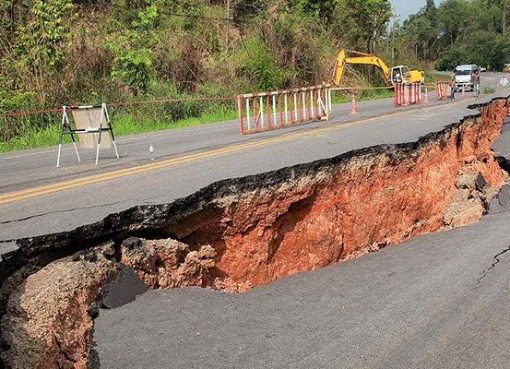Tacheometry surveying is defined as the branch of surveying in which horizontal and vertical distances between stations are determined from instrumental observations. In this method, no tape or a chain is used for measuring horizontal distances.
This method is very rapid and convenient. The instrument which is used for tacheometric purposes is known as a tachometer. The accuracy of tacheometry distances is such that under favorable conditions, the error seldom exceeds 1 in 1000.
Purpose of Tacheometric Surveying
The primary object of tacheometry is the preparation of countered plans. It is considered to be rapid and accurate in rough country and has thus been widely used by engineers in location surveys for railways, canals, reservoirs, etc.
Tacheometry provides more accuracy on distances measured with a tape or a chain.
Advantage of tacheometry surveying
The advantage of tacheometry surveying are as follows;
- The speed of surveying is extremely high.
- The accuracy of this surveying in uneven or difficult terrain is quite satisfactory.
- The cost of surveying is a smaller amount.
- It is not required any tedious jobs with chains and tapes.
- It is useful where a plane table survey or chain survey cannot be conducted (hilly areas, hydrographic sites).
What are the instruments used in Tacheometric surveying?
The following instruments are used :
Tacheometer
A tachometer is essentially nothing more than a theodolite fitted with stadia hairs, is generally used for tacheometric surveying.
The stadia diaphragm of the tachometer has two hairs, one is above, and the other is below the horizontal crosshair at equal distance.
The stadia hairs are kept in the same vertical plane as the horizontal and vertical crosshairs.
Stadia rods

For short distances ( say up to 100 meters) ordinary leveling staves may be used. For greater distances, the stadia rods 3 to 5 meters in length, are generally used.
Principle of tacheometry
- In isosceles triangles, the ratio of the perpendicular
- From the vertex on their bases and base is constant.

- The value of constant K entirely depends upon the magnitude of the apex angle.
- For horizontal sights, the difference in elevation of the instrument station and staff position is deduced in a similar way as in the case of differential leveling.
System of tacheometric measurements
The various systems of tacheometric measurements may be classified as:
- The stadia hair system
- The tangential system
1) Stadia hair system
The stadia hair system may further be divided into two types:
- Fixed hair method
In this method, stadia hairs are kept at a fixed interval and the intercept on the leveling staff ( or stadia rod) varies, depending upon the horizontal distance between the instrument station and the staff.
When the staff rod intercept is more than the length of the staff, then only half an intercept is read, which must be equal to the difference between central stadia hair reading and the lower or upper stadia hair reading.
- Movable hair method
In this method, the intercept of the leveling staff is kept constant and the distances between the stadia hairs are variable.
Targets on the staff at a given distance apart are fixed & the stadia hairs are adjusted such that the upper target & lower hair bisects the lower target. In this case, a provision is made for the measurement of the variable interval between the stadia hairs.
2) The tangential method
The stadia hairs are not used, in this method. Readings on staff are taken against the horizontal crosshair. To measure the staff intercept, two pointing of the telescope is, therefore, necessary.
Reading to full meter values on the staff is generally taken to avoid the decimal part and also for simplification of computations. This method is not adopted as two vertical angles are required to be measured for one single observation.
Procedure for Tacheometric surveying
The procedure of tacheometric surveying is as follows;

- Set the instrument over the station and accurately level the instrument with relation to the altitude level.
- Set up the vernier of the vertical circle to zero. With the altitude level in the middle of its run, measure the height of the instrument with a measuring tape accurately.
- Now, orient the instrument, this is often done as follows,
- The reference meridian may be a true meridian or magnetic meridian.
- When the reference meridian is a magnetic meridian, set the vernier to zero and resolve the telescope about the vertical axis.
- For orienting the instrument with respect to truth meridian, the true bearing of a reference or another station of the traverse with respect to the primary station should be known.
- Then, set the vernier to read this bearing and resolve the telescope at the outer axis until the station or the reference object is bisected.
- Put the staff on the benchmark & take a bearing, read the vertical angle & the bottom, top, and axial hair readings.
- All the representative point on the command of the instrument station are located by taking vertical angles, bearings, and the staff readings.
- After all the points are located from the first station, then take a foresight at the second station and note the bearings.
- Move the instrument to the second station. Set up the center and level of the instrument and measure the height of the instrument as before.
- And, take back sight to the first station & also observe the vertical angle, bearing, and staff reading to the top, bottom, and axial hairs.
Formula used in Tacheometric Surveying :-
The stadia method – Fixed hair method
a) Distance and elevation formula for horizontal sights:
- Horizontal distances of the staff position:

Where, D = Horizontal distance from the axis of theodolite to staff
f = Focal length of the object lens
s = Staff intercept
i = stadia hair interval
d = the distance between the optical centre of the object glass and the axis of the theodolite.
- Elevation of the staff station:
Elevation of staff station = Elevation of the instrument axis – central hair reading
b) Distance and elevation formulae for inclined sights with staff vertical:
1) Horizontal distance formula:


2) Elevation formula
- For angle of elevation
Elevation of point E = H.I + V – h
- For angle of depression
R.L of Point E = H.I – V – h
C) Distance and elevation formula for inclined sights with staff normal:
Case I : Line of sight at an angle of elevation
- Horizontal distance formula


Where, s = staff intercept
h = central hair reading
= Angle of elevation for central wire
- Elevation of the staff station:
RL of E = H.I + V – hcos
Case-II : Line of sight at an angle of depression:
- Horizontal distance formula:

Application of Tacheometric Surveying
The application of tacheometry surveying are as follows;
- It is used for the counter map’s preparation when both horizontal and vertical distances are needed.
- It is useful for triangulation surveying.
- Sometimes surveying work is in difficult areas where it is not possible to use some direct methods like plane table surveying or theodolite surveying.
- The tachometer is like a reconnaissance survey for roadways, highways, or railways.
- It may be used as the establishment of secondary control points.
Source: civilconcept











Kohl’s is a well-known American department store that values customer feedback. Through their official survey, which is available at https://www.kohlsfeedbackscom.com/, customers have the opportunity to share their opinions and experiences. In an exciting development, Kohl’s has announced that participating in the survey grants customers a chance to win a generous prize – a $2500 coupon. This incentive encourages customers to provide their valuable feedback while also giving them the possibility of enjoying substantial savings on their future purchases at Kohl’s.